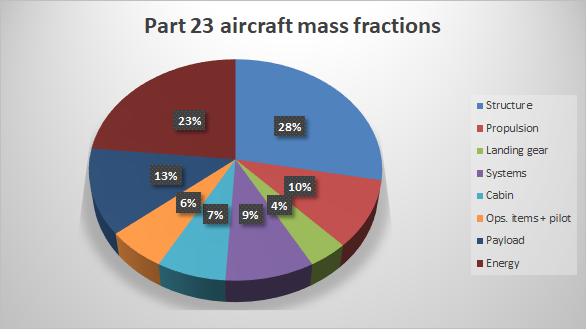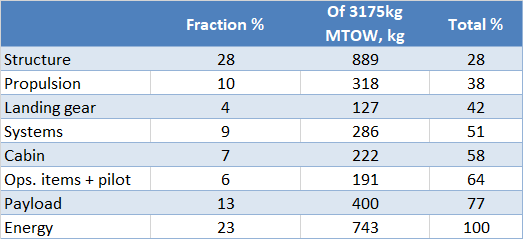Leeham News and Analysis
There's more to real news than a news release.
Bjorn’s Corner: Sustainable Air Transport. Part 39. VTOL design realities.
September 30, 2022, ©. Leeham News: Last week, we discussed how the pilot should control the eVTOLs that enter the market in three to five years. The absence of a standard for pilot interaction with the VTOL is troubling.
Having gone through the market’s major eVTOLs, their flight principles, and the key systems, we now look at how it all fits together. What payloads can be flown to what range? What will be the operational costs, and how green will it all be? We start by looking at some design realities for eVTOLs.
eVTOL design realities
As for the battery electric aircraft discussed before, design realities affect eVTOLs, like all aircraft designed around the Part23/CS23/SC-VTOL rules. Rather than pinpointing a specific design, we discuss these realities around a generic design, representing the class of eVTOL we have looked at.
We start with the biggest problem for any aircraft designer, the reality of mass. Underestimation of the mass of a new aircraft design is a chronic disease among aircraft design teams, and there seems to be no cure. There isn’t a project where the initial mass estimation has been correct or too high.
Experienced aircraft design teams miss the initial mass projections by about 5% once the aircraft is finished and certified, and inexperienced teams by up to 20%.
It’s not too difficult to understand what masses we would have for our generic eVTOL. We assume it’s a Pilot + four-passenger model that uses vectored thrust for half its lift engines to fly a winged forward flight. Such designs likely end up at the SC-VTOL maximum allowed mass of 3175kg. From this, we can deduce the probable Operational Empty Weight, OEW (which includes the pilot).
OEW versus MTOW
We have hundreds of aircraft that passed Part 23/CS23 certification, so there is an abundance of experience in what these rules mean in mass fraction OEW to Maximum TakeOff Weight, MTOW.
Fabio Russo, head of development at Tecnam, has decades of experience with such designs, including the electric Tecnam P-Volt. He made the Figure 2 graph for a paper about the Alice electric aircraft. You find it here.
The graph shows we shall expect our eVTOL OEW mass to come in at ~64% of MTOW if it was a Part 23 aircraft. Let’s discuss the differences between a Part 23 aircraft and our eVTOL and whether these increase or reduce the OEW.
The typical mass fractions for the different parts of a Part 23 aircraft are given in Figure 3.
If we apply these fractions to our 3175kg aircraft, we get the table in Figure 4.
Now to the differences:
We have a clear difference in the propulsion. Instead of a thermal engine with propeller+hub with ancillaries, we have eight electric motors with propeller+hubs, where four are tiltable. The takeoff power needed for the Part 23 aircraft is typically 250 to 300kW, whereas for our vertical starting eVTOL, we need to double that. We will be lucky if we can realize the eight electric motors with propeller/hubs and tilt mechanism within 320kg.
The structure of an eVTOL is more complex than the aircraft as we have eight lift forces that enter the structure sitting on booms. The eVTOL OEM will argue he is using composites versus aluminum for the Part 23 aircraft. This will reduce the mass of the eVTOL structure.
The problem is composites are no game changer for structural mass. A CFRP (Carbon Fiber Reinforced Polymer) part is strong in tension, where up to a 20% mass gain can be made IF TENSION is the design problem for the part! In compression (by definition, the other half of the wing/fuselage/horizontal tail), CFRP is not good as then the matrix resists the buckling rather than the fiber.
And large parts of an aircraft/ VTOL are damage tolerance limited from the impact of rain, hail, and ramp rash. Here CFRP is at a disadvantage compared with aluminum as it’s brittle. It means a lot of parts will have their CFRP dimension, and thus mass, decided by toughness criteria rather than tensile strength.
The bottom line: There are no significant mass gains to make in the structure of the eVTOL with CFRP. The form and surfaces of the eVTOL can be shaped more optimally, but the structural mass will not be much different than for a Part 23 aircraft made with aluminum.
A complication for the eVTOL is the storage of the batteries. The energy in the Part 23 aircraft is fuel stored in the wingboxes on each side. It’s an ideal placement and almost for free as the fuel mass is where the lift attacks the structure, and the wingboxes’ strength is decided by aerodynamic forces. There is no structural penalty for the energy storage. You only pay with sealant, pipes, valves, and pumps to get the energy to the thermal engine.
The battery modules, at a total of 745kg, are heavy items that must be stored crashworthy. These can be stored in the wings, which structurally would be best, but this complicates several aspects of thermal runaway protection and battery service/management.
The bottom line of the mass analysis is that our likely OEW is at least 64% of the MTOW of 3175kg. To this, we add 400kg of passengers, and best case, 745kg of batteries. What this means for the energy content and range we look at next week.







Structure, payload and batteries mass are dependent on size and range. If designed for inter city flight of up to 20-30 minutes for pilot and 2 pax with briefcases it becomes easier. One think the mass would come down, just compare to a very structurally safe F1 car “The minimum allowed weight of a Formula 1 car is 798kg. This is the mass of the car with the driver, fitted with dry-weather tires, but without fuel”. In the 1960s, 450-530kg (992-1,168lbs).
I was a bit shocked by one comment after the Linkedin Alice evaluation.
Russo is head of development for Tecnam , a company with a fairly newly certified 9 passenger high wing twin. ( piston engines with an electric version under development, the P-volt)
Unlike the ’30 yr experienced Boeing structural engineer’, ( and now Eviation consultant) he knows what hes talking about- for a whole aircraft- in this specific size and capability aeroplane.
https://en.wikipedia.org/wiki/Tecnam_P2012_Traveller
Bjorn: you certainly want to say that all projects estimate the mass too low, so it should be ‘There isn’t a project where the initial mass estimation has been correct or too high.’
Of course, thanks.
One if the reasons for this chronic missing is the spiral factor. If a component of the vehicle turns up to heavy (let’s say landing gear), the structure of the aircraft needs reinforcement, not only the attachments of the landing gear but also other structure parts as through a gust, the area around the heavier gear needs beefing. As other parts get heavier, the wing root needs beefing. To keep everything on the same stress level, you talk about the spiral factor. On the aircraft projects I worked on, it was around 3, i.e., every kg increase meant the MTOW increased by 3kg to keep the aircraft spec.
The designers are focusing to the propulsion energy balance mostly, Very few if any takes into consideration the energy needed for the 7/24 commercial operation and comfort. High net worth individuals will not swet in the cabin they demand A/C. 7/24 operation requires de- or anti-icing, winter mode requires cabin heat all of them are energy hungry and increasing mass.
Bjorn, if you are going to continue to do this and expect the analyses to be taken seriously by people (such as myself) who are dubious about the prospect of this being ‘environmentally friendly’ or solving some semblance of a problem to go through such a hassle of installing/designing a mathematically silly propulsion/power system in an aircraft, you should also include at least a topical analyses of the total input required to fabricate, maintain, and dispose of the power storage (the huge batteries) over it’s lifetime.
How many tons of earth must be strip mined, where, total amount of water/carbon used to refine all of those inputs, and also then include the thermal management of the batteries (via cooling fluids etc.) as is done in cars/trucks that are BEV powered. Then include the likelihood that they are disposed of within 10 years with less than 1.5 percent to be recycled/re-used.
What is the real impact on the planet, and how many kids/slave laborer hours would be involved in the extraction/refining/production of these systems, today? This evtol concept necessarily will outsource production of the matériels for the batteries to China, as an example of a point not addressed. How many of these matériels will be refined using the coal/soon to be built coal plants there?
https://time.com/6090732/china-coal-power-plants-emissions/
Similarly for kid-glove treatment of discussions with engine mfg’s about SAF, where exactly is the food-based input going to come from? What countries should sacrifice current and future food needs to make more sustainable aviation fuel?
@Texl: As it happens, my Pontifications scheduled for Monday is on point about mining, battery recycling, etc.
Hamilton